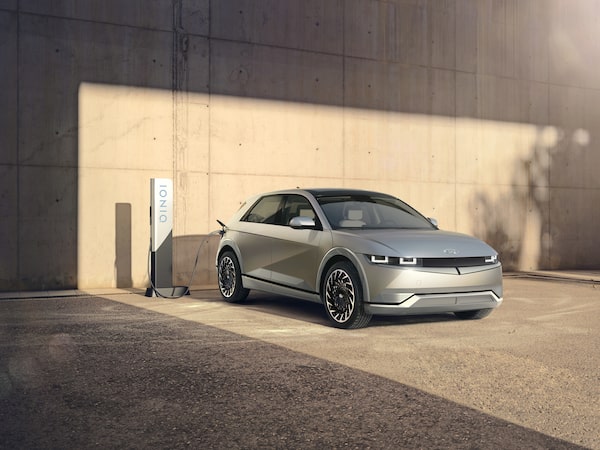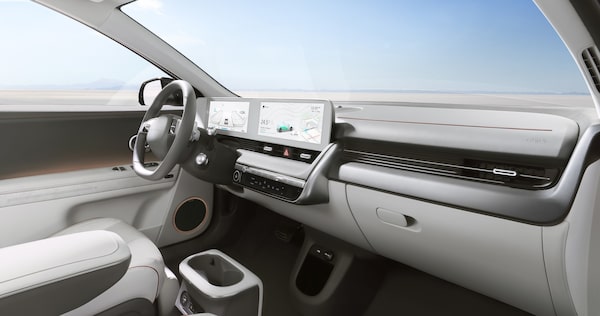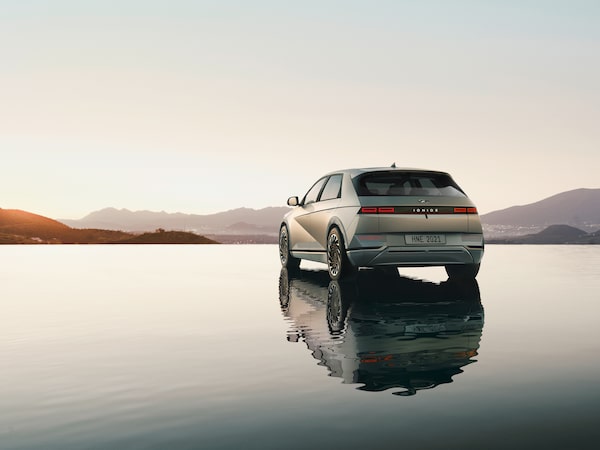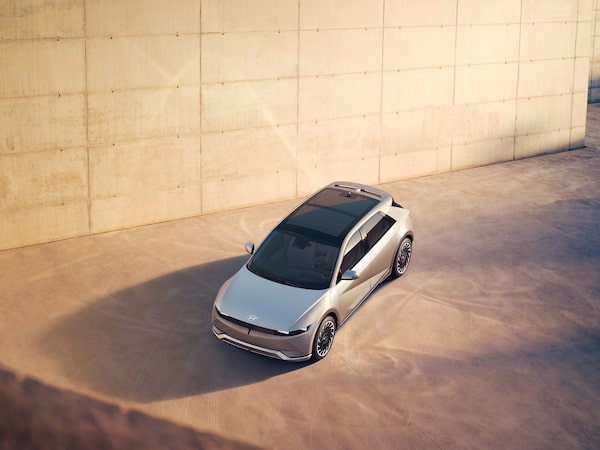
The new Hyundai Ioniq 5.Courtesy of manufacturer
Hyundai’s new Ioniq 5 battery electric vehicle, which will come to Canada late this year, is like Dr. Who’s TARDIS – much bigger on the inside than it looks.
The mid-sized crossover is just five mm longer in total length than the company’s Tucson SUV, yet its three-metre wheelbase is 50 mm longer than the full-sized, three-row Palisade SUV. This gives it the space and cargo capacity of a much larger conventional vehicle.
Much of the reason is because it’s built on Hyundai’s new Electric-Global Modular Platform (E-GMP), which is like a flat skateboard that holds the heavy batteries down low and keeps the wheels at the far corners. There’s no engine under the hood, so there’s ample leg room for the driver and four passengers.
In the front, there’s a sliding centre console and armrest between the two seats that can move backwards 140 mm; this leaves a flat floor between the driver and passenger that can function as a walk-through if wanted. The transmission is a simple stalk on the steering wheel, like on a Mercedes.

The Ioniq 5 will be loaded with cutting-edge driver’s-assistance technology.Courtesy of manufacturer
There’s still plenty of cargo space: 531 litres behind the rear seats, which is larger than most mid-size trunks, and 1,591 litres when the rear seats are laid flat. There’s even a small front trunk, or “frunk,” in the space under the hood where most cars have their engines.
The Ioniq 5 is a completely electric vehicle that will be available in Canada with either a 58 kWh or 72.6 kWh battery pack, and in either rear-wheel drive or all-wheel drive editions. The maximum range for the RWD with the larger battery pack is estimated at more than 450 km. The fastest version of the car will accelerate from zero-to-100 km/h in 5.2 seconds.
No prices have yet been announced.
Perhaps most important, the Ioniq 5 will offer standard 800-volt charging while also allowing 400-volt charging. This will take advantage of the higher capacities that are starting to be offered at fast-charging stations, including the 350 kW chargers being installed across Canada by Petro-Canada, but will still permit regular charging if needed. Hyundai is also actively working on wireless charging applications for the platform.

The Ioniq 5 is expected to land in Canadian showrooms by November.Courtesy of manufacturer
This ultra-fast charging technology allows the Ioniq 5 to charge from 10 per cent to 80 per cent in 18 minutes, when plugged into an appropriate commercial charger. Five minutes of charge will provide about 100 km of driving range, though charging times will be considerably slower at less powerful charging stations.
The Ioniq 5 was introduced in Korea this week at a virtual event for international journalists, and it appears still very similar to the Concept 45 car seen at last year’s Montreal and Toronto auto shows. It has cameras for side mirrors, and available 20-inch wheels, as well as unique daytime running lights and rear lights that seem more like pixels on a screen than traditional bulbs.
The interior uses sustainably-sourced materials wherever possible for its seats, headliner and trims, made from things like recycled plastic bottles, plant-based yarn and eco-processed leather.
“We believe a sustainable society is not an option anymore,” said SangYup Lee, Hyundai’s head of global design. “This is something that we must deliver and we’re taking it very seriously.”

The exterior has a sloped rear window and a long clamshell hood.Courtesy of manufacturer
The exterior design actually borrows from the original Hyundai Pony of 45 years ago, sharing a sloped rear window and a long clamshell hood. This is why the concept update was called the “45.”
“We’re actually moving forward to the future by respecting the past,” said Lee. “This means there’s a little bit of analogue in the world of digital.”
The Ioniq 5 will be loaded with cutting-edge driver’s assistance technology, including the second generation of Highway Driving Assist (HDA2), which can change lanes automatically around slower vehicles. Currently, Teslas are the only production cars that can do this automatically.
This is the first of 23 Hyundai, Kia and Genesis battery electric vehicles to use the new E-GMP platform. The Hyundai Motor Group, which owns the three brands, has stated a goal of selling one million BEVs globally by 2025. Hyundai expects to sell the Ioniq 6 performance sedan next year, and the full-size Ioniq 7 SUV in 2024.
The Ioniq 5 begins production in Korea next month and will be first sold there and in Europe, coming to North America later this fall. The company expects to sell 70,000 Ioniq 5s this year. Canadian models are expected in showrooms by November, and pricing will be announced closer to the release date.
Shopping for a new car? Check out the Globe Drive Build and Price Tool to see the latest discounts, rebates and rates on new cars, trucks and SUVs. Click here to get your price.
Stay on top of all our Drive stories. We have a Drive newsletter covering car reviews, innovative new cars and the ups and downs of everyday driving. Sign up for the weekly Drive newsletter, delivered to your inbox for free. Follow us on Instagram, @globedrive.